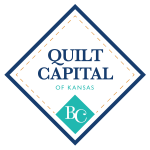Timeless Stitches
Published in The Baldwin City Community News
March 2, 2022

--Liz Granberg-Jerome
Let’s dive in on the quilting lingo with Liz and start with machines. One of the first acronyms listed in the list was DSM, which stands for Domestic Sewing Machine. With few exceptions for specialty hand sewing techniques, nearly every quilter owns at least one sewing machine for piecing. They are the primary tool for quilters as they cut up fabric and sew it back together into new configurations to become quilt tops.
Sewing machines as we know them today first appeared in England in the mid-1750s. Charles Fredrick Wiesenthal, a German-born engineer living in England, was granted in 1755 a patent for his mechanical device to aid seamstresses and tailors in the art of sewing. Back then it would have been primarily for the construction of garments, shoes, or other items made with fabric. Sewing machines have come a long way since then. The machines have evolved from hand-crank versions to machines mounted in cabinets with a treadle connected by a belt so it could be powered with your feet as your hands fed the fabric under the needle, to the first electric models that became popular in the mid-1800s, to the modern computerized versions that many of us use today.
The earliest machines created a simple chain-stitch using a single thread. The first lock-stitch machine that used two threads appeared in the 1830s and had a shuttle holding the lower thread. By the 1840s, the best features of these early models were combined into the modern machines still in use today. Changing the design for the lower thread from the shuttle to a bobbin was a great improvement. Many of these hybrid design machines were patented in the 1840s by the likes of Singer, Howe, and Fisher.
Today’s quilters use a wide variety of machines to sew the pieces of quilts together from a plethora of designs available to them to create unique projects. The most popular machine brands today include Bernina, Brother, Babylock, Singer, Pfaff, Janome, Elna, Viking, Kenmore, and more. Many quilters have machines that have been in their families for generations, previously used by their mothers or grandmothers. Others may favor the brands their predecessors used. Still others may choose a different brand for specific features offered on the ever-evolving modern machines.
There definitely has been a resurgence in popularity of using vintage sewing machines in the last few years, especially the classic Singer Featherweight sewing machines that were made from 1933 through 1969. The Featherweights are favored for being light weight, made with metal components, a straightforward construction, and can easily be serviced and maintained at home. Unless a zigzag stitch is desired or some specialty decorative stitch to embellish a project, the simplicity of the straight stitch Featherweight seems to be the perfect machine. Over the last dozen years or so, Liz has been attending quilt retreats where she quilts alongside fellow quilters, offering encouragement to each other, and generally having a good time sewing with friends. The number of Featherweights being used at retreats has increased exponentially over bringing the often much heavier and larger computerized modern machines.
Regardless of the type of machine they use, nearly all quilters use some sort of domestic sewing machine when piecing their quilt tops.